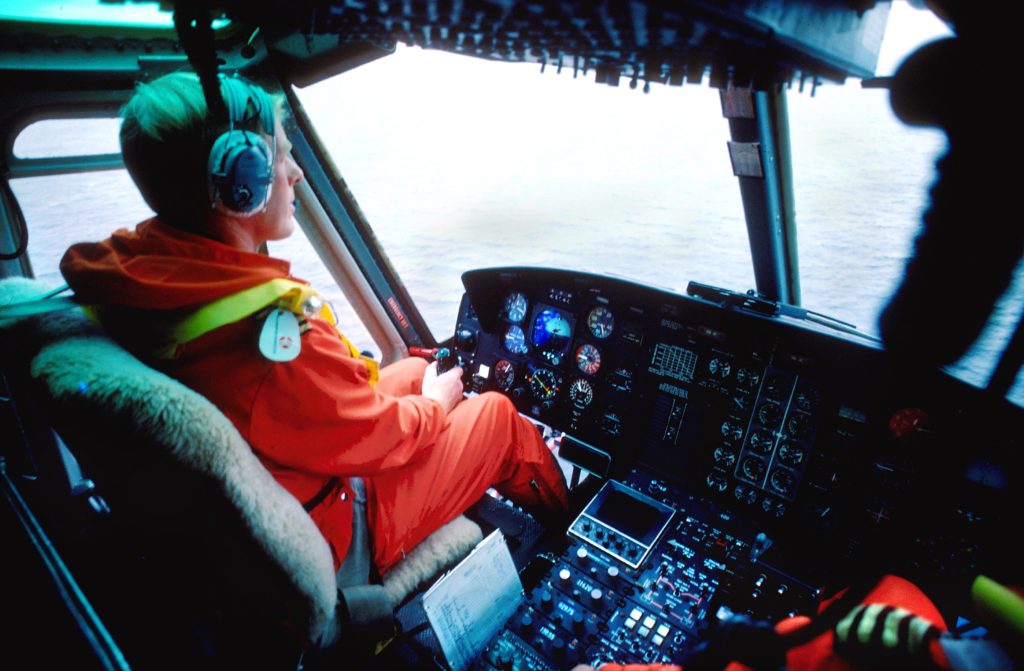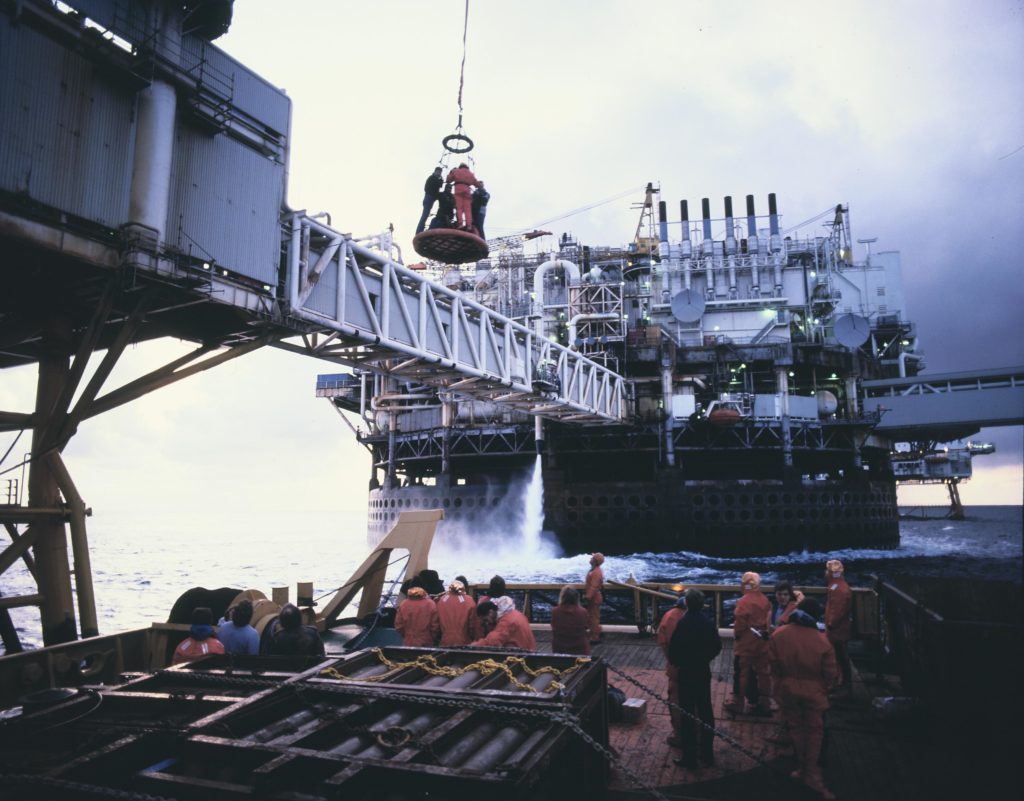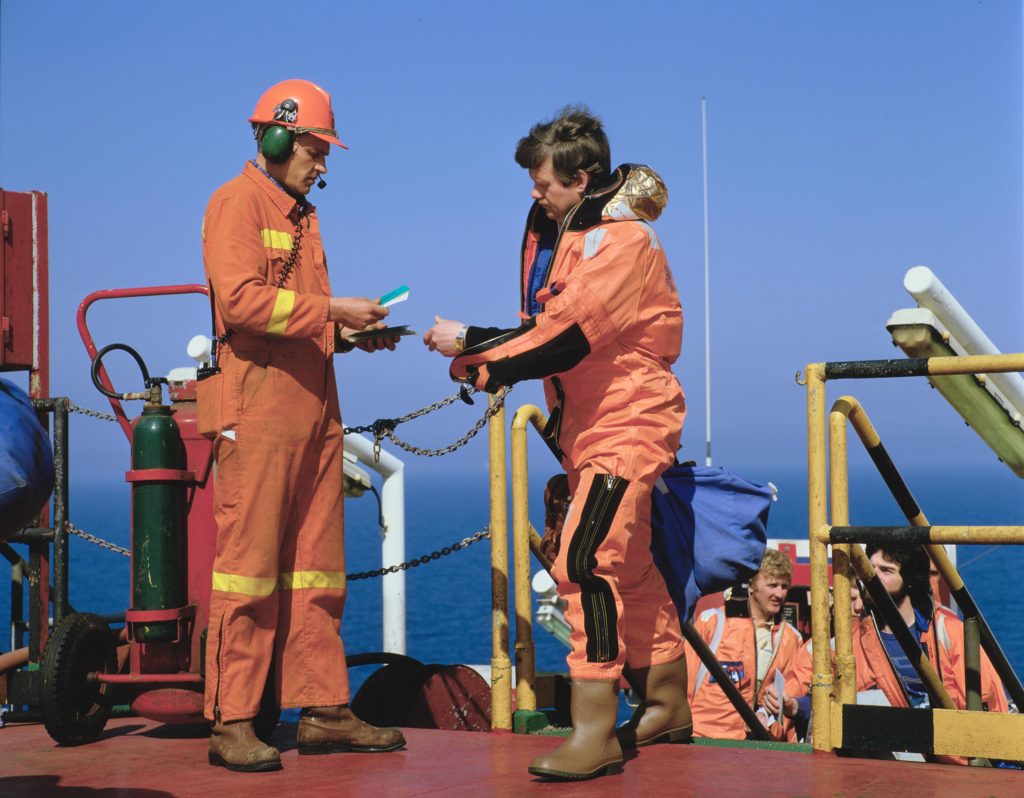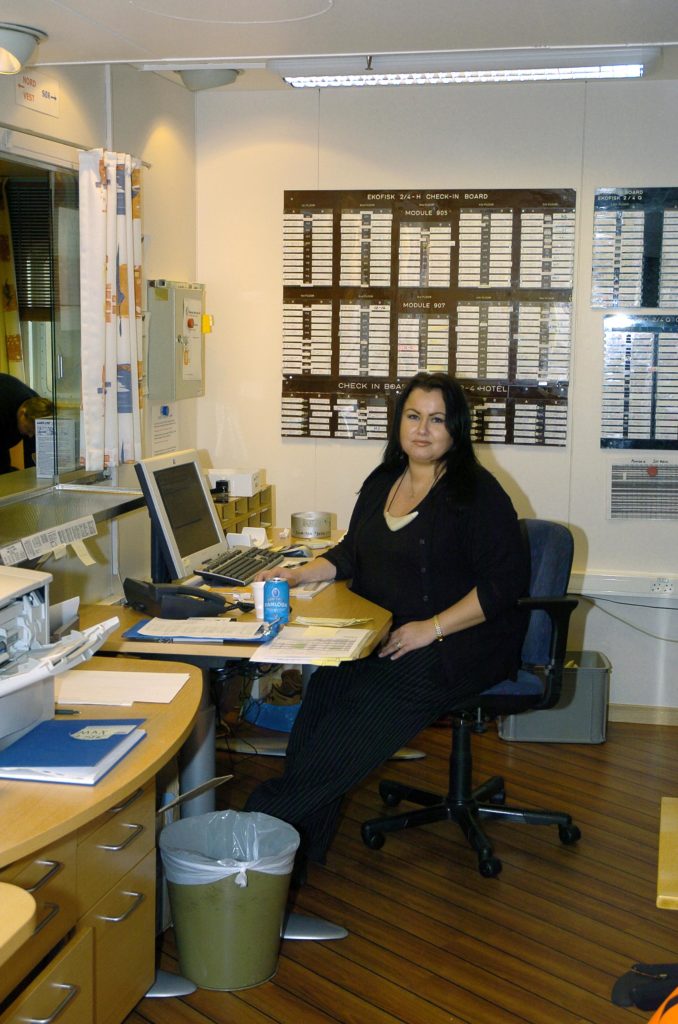Logistics, traffic and communication

 arbeidsliv, logistikk, helikopterpilot,
arbeidsliv, logistikk, helikopterpilot,An average of seven helicopters take off daily from Stavanger Airport Sola for Ekofisk. Flown by experienced pilots, all return the same day. The flying time is about 90 minutes, depending a little on wind direction.
In 2000, 26 000 passengers were carried between Sola and Ekofisk by Helikopter Service, which runs these flights under contract with Phillips.
It operates two types of Super Puma helicopters. The L1 has 18 seats but only takes 14 passengers with a full fuel tank, while the L2 is a little larger. It has 19 seats but normally takes 18. Everyone must wear a survival suit during the flight.
 arbeidsliv, trafikk, logistikk, helikopterpilot
arbeidsliv, trafikk, logistikk, helikopterpilotThe first helicopters used were Sikorskys. In 1978, the Boeing BV 234 Chinook was introduced for flights to and from the Ekofisk Complex.
These were much larger than today’s machines, and could seat 44-46 passengers. They even carried cabin attendants who served coffee.
Two Bell 212 machines originally used to shuttle people between the Greater Ekofisk platforms have been replaced by a pair of Dauphins.
Regular flights between the platforms are often concentrated in the morning, midday and evening shuttles. In the most hectic periods, helicopters land on the 10 Ekofisk helidecks a total of 200 times a day – shuttles and flights to and from Sola.
Dauphin helicopters also provide medical evacuation and the search and rescue (SAR) service introduced in 1982. People can be plucked from the sea by lowering personnel on a line.
Six pilots, two mechanics and two rescue personnel are present in the Greater Ekofisk Area (GEA) at all times.
Air transport supervisor
The air transport supervisor obtains and receives information about activities and manning on Ekofisk in order to plan the scale of helicopter traffic. Their department also registers all parcel post with contents, sender and recipient.
Everyone who travels to the Greater Ekofisk Area is issued with a Dawinci ID, which has replaced the earlier MTS code.
That makes it possible to chart their movements in the event of an accident. Checks can also be made that everyone going offshore has a valid medical certificate.
Supply service
 Arbeidsliv, logistikk, forsyning, supply, yrke, offshore,
Arbeidsliv, logistikk, forsyning, supply, yrke, offshore,A supply ship puts out for Ekofisk from the quay at Tananger six days a week. That adds up to about 312 departures by Sound Truck, Scandi Fortune or Active Girl during a year.
These pure supply ships have roughly 800-900 square metres of deck space. In addition, Phillips has four multipurpose vessels, including two able to function as firefighting ships.
All can also be used for standby services and carry man-overboard (MOB) boats, while two are equipped for anchorhandling and towing rigs.
At least one ship with extra firefighting gear must always be present on the field. In addition to the supply ships, Phillips has two pure standby vessels – Strilfisk and Striløy – stationed at the B11 and H7 platforms.
The supply ships deliver everything from food and water to bedding, diesel oil and tools. Water is the biggest single consignment, adding up to 267 000 tonnes in 2000.
Sailing time from Tananger to the Greater Ekofisk Area is about 12 hours, and covers roughly 165 nautical miles. Crew usually serve four-week tours of duty, separated by four weeks off.
Heliguards
 arbeidsliv, trafikk, logistikk, helivakt, engelsk,
arbeidsliv, trafikk, logistikk, helivakt, engelsk,A heliguard assists helicopter pilots during landing on and takeoff from a platform, as well as responding to possible helideck fires.
Roustabouts often serve as heliguards. They stow passenger luggage before takeoff and unload it to helideck on arrival for the passengers to carry away with them after disembarking.
Arriving passengers go direct to the Sky Lobby – or arrivals/departures area – and are sent on to other parts of the Ekofisk Complex or by shuttle to another platform.
 Logistikk, trafikk og kommunikasjon,
Logistikk, trafikk og kommunikasjon,On arrival in the lobby, they register with the receptionist and receive an electronic tag before heading for their cabin on Ekofisk 2/4 H or 2/4 Q.
The receptionists are responsible for booking seats on flights to land and all shuttling from the Ekofisk Complex, as well as for coordinating and prioritising who is to take what flight. Most of their work is now computerised.
They also allocate cabins. Capacity is usually full on 2/4 H and 2/4 Q, and fitting everyone in can be a bit of a jigsaw when a lot of work is under way.
The Ekofisk Complex collaborates with the outlying cabins on beds, and daily shuttling is generally needed to bring people to their workplace from the accommodation platform.
Other duties for the receptionists include answering telephone calls and post, and responding to e-mails.
Radio operators
 arbeidsliv, logistikk, trafikk, kommunikasjon, radiooperatør
arbeidsliv, logistikk, trafikk, kommunikasjon, radiooperatørThe primary job of the radio operator (or “sparks”) is to handle contacts between platform and land, rigs, supply ships, other installations and the helicopters.
Their work has been changed greatly by technological advances, but they still need to be fully qualified to use radio – and know how to send and receive Morse. VHF is normally used.
Radio operators were initially recruited from qualified Norwegians with several years of experience from the merchant marine.
All manned platforms on Ekofisk have a radio operator, and there was earlier one on each shift. When the tour rotation is taken into account, this meant there were 5.5 people for each of these jobs on every platforms.
During the 1990s, the whole organisation was restructured to enhance efficiency. Other people, such as the medic, were then required to handle the radio operator function on the night shift, greatly reducing the number of these specialists.
On the satellite platforms, the radio operators monitor helicopter traffic and possible vessel movements if and when required.
Their radio systems are available for conversations with ships, aircraft, the Ekofisk Complex, Norway’s coast radio stations and so forth.
Should an accident occur which requires important messages and alarms to be transmitted, an electronic system goes into action and sends predetermined signals.
The largest number of radio operators is on Ekofisk 2/4 H. A new control tower became operational there in 1987, which permitted efficiency improvements. Monitoring of air and sea traffic could be combined with weather observations.
Ships are monitored by the vessel coordinator with the aid of a radar system on Ekofisk 2/4 T. This scans the horizon around the clock and picks up all movements at sea, whatever the weather.
The air traffic control job is split in two. One operator keeps an eye on where the helicopters are at any given moment, while the other monitors shuttling, passengers, freight and fuel.
Communication with the Sola heliport takes place via satellite. The Ekofisk control room takes charge of flights from Sola when they are about 40 nautical miles away, contacting them by radio with information on weather, cloud cover and so forth.
Technical communication
A tea, of highly qualified personnel on Ekofisk and at the Tananger base take care of technical communications, with facilities which include a satellite ground station on the field.
In addition come equipment for data and process control, over-the-horizon radio, radar, electronic telephone exchanges, video systems, laser-beam radar detectors and so forth.
 arbeidsliv, logistikk, kommunikasjon, teknisk,
arbeidsliv, logistikk, kommunikasjon, teknisk,The flow of oil and gas is paralleled by floods of speech via telephone, data transmitted between computers, texts from word processing systems, and telexes sent via fibreoptic cables. Messages pass day and night between the platforms and the land facilities at Tananger, Teesside and Emden.
Initially, communication between the Ekofisk Complex and the satellite platforms utilised line-of-sight radio transmission. Switching to satellite communication marked a big step forward.
That used geostationary units 36 000 kilometres above the Equator transmitting to or from a ground station at Moi in Norway and from/to Tanager, the Sola control tower and so forth.[REMOVE]Fotnote: Kvendseth, Stig S, Giant Discovery. A History of Ekofisk Through the First 20 Years, 1988.[REMOVE]Fotnote: It became possible in 1986 to receive TV signals via satellite directly from mainland Norway. Ekofisk was thereby able to pick up news and other programmes directly at the same time as home audiences.
With the Ekofisk II development, fibreoptic cable technology was introduced for communication between the installations and onshore personnel.
ConocoPhillips has installed an onshore drilling centre (ODC) at Tananger, where a control room manages and supports activities on Ekofisk.
Although drilling is the first function to be moved to land in this way, the company expects to extend this concept to the other disciplines over time.






